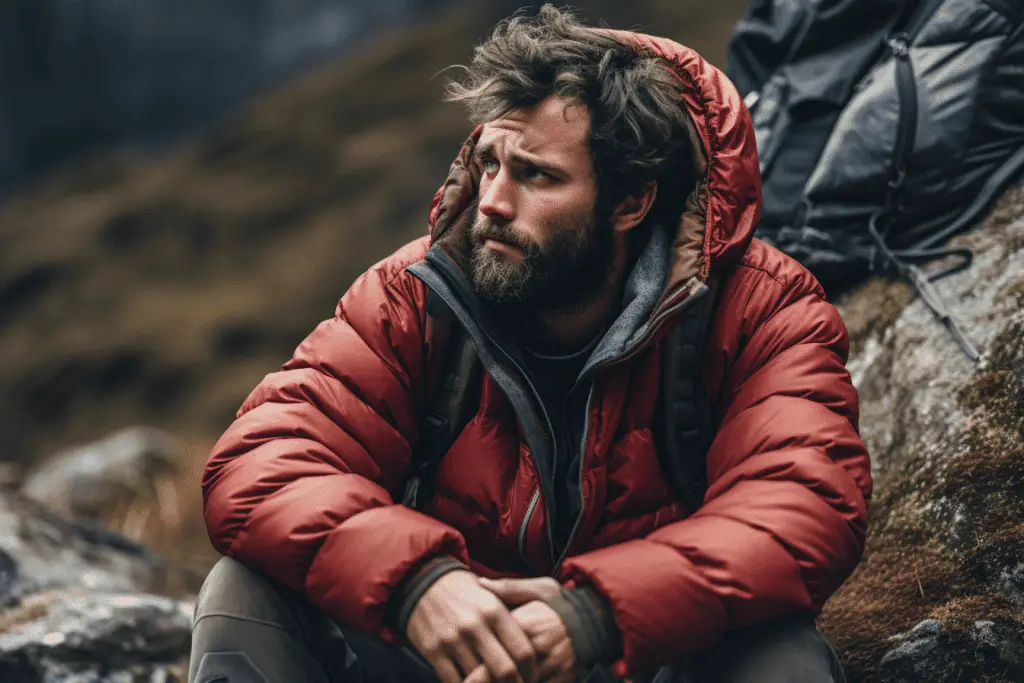Welcome to the great insulation debate – Down vs Synthetic Jackets. If you’re an outdoor enthusiast or someone who just can’t handle the chill, you’ve probably found yourself stuck in this conundrum at some point. These two types of jackets, both popular for their unique advantages, are designed to keep you warm in the colder months. But which one is the best?
Down jackets are the traditional favorites, filled with the soft and fluffy layer found underneath a bird’s feathers, typically from ducks or geese. These jackets have been around for a while and are known for their incredible insulation properties, lightweight nature, and the coziness they bring – like wrapping up in a comfy duvet.

On the other hand, we have synthetic jackets. These are the new kids on the block, made from man-made materials designed to mimic the warmth of down, but with a few extra advantages. You’ve probably heard names like PrimaLoft or Polartec – these are brands making synthetic insulation. While these jackets might not be as light or compressible as down, they have a reputation for maintaining warmth even when wet, and they’re often more durable.
So, we’ve got the classics and the innovators – down and synthetic jackets. Both are designed to keep you snug in frosty weather, but each has its own unique strengths. Now, the real question is, which one suits your needs better?
Advantages and Disadvantages of Down Jackets
First off, down jackets are famously known for their incredible warmth-to-weight ratio. If you’re venturing into extremely cold climates or high-altitude treks, down insulation is going to give you the most heat for the least amount of weight. This is because the down clusters trap air very effectively, creating a strong thermal barrier. So, you’ll stay toasty warm without feeling like you’re lugging around a heavy coat.
Now let’s talk about compressibility. Down jackets can be squeezed down to a compact size, which is a significant advantage if you’re backpacking or traveling. Imagine being able to stuff your jacket into your bag’s small compartment – that’s the convenience down offers! Plus, they bounce back to their original fluffiness once you take them out, ready to keep you warm again.

Durability is another strong point. Down jackets can last for years, even decades, if taken care of properly. While they may seem delicate, they can withstand the wear and tear of outdoor activities. And while they do require careful washing, this doesn’t have to be done frequently, which contributes to their longevity.
However, despite all these advantages, down jackets aren’t perfect. They have a few weaknesses, the most notable being their performance in wet conditions – they lose their insulating properties when damp. But if you’re looking for maximum warmth with minimum weight and size, and you’re mostly venturing into dry, cold conditions, a down jacket could be your best friend!
Here’s a simple table that outlines the pros and cons of down jackets:
| Pros of Down Jackets | Cons of Down Jackets |
|---|---|
| Excellent warmth-to-weight ratio | Lose insulating properties when wet |
| Highly compressible, ideal for travel and backpacking | Require careful cleaning and maintenance |
| Extremely durable, can last for years if properly cared for | Often more expensive than synthetic counterparts |
| Lightweight, making them comfortable for long wear | Potential allergen for some people |
| Natural material, considered more environmentally friendly in some aspects | Ethical concerns over sourcing of down |
| Retains heat well in dry, cold conditions | Not the best for highly active pursuits, where you might sweat |
| Can often pack into an internal pocket for easy transport | Takes longer to dry when they get wet |
Advantages and Disadvantages of Synthetic Jackets
To start with, one of the biggest advantages of synthetic jackets is their ability to retain warmth even when they’re wet. Unlike down, which clumps together and loses its insulating power when damp, synthetic insulation continues to keep you warm. This is a crucial factor if you’re heading into a damp or rainy climate, or will be encountering snow that might melt on your jacket.
Next up, let’s talk about durability and maintenance. Synthetic jackets are generally pretty tough and can handle a bit of rough and tumble. They’re less prone to damage from moisture, oils, and dirt, and can be cleaned more easily than down jackets. That’s why they’re often a go-to for people involved in intense outdoor activities.

Also, when it comes to cost, synthetic jackets often come out on top. They are usually more affordable than down jackets, making them a more accessible option for those on a budget. But don’t assume that a lower price means lesser quality – synthetic jackets still offer excellent performance.
And finally, if you’re concerned about animal welfare, synthetic jackets have an advantage. Unlike down, which is harvested from birds, synthetic insulation is made from man-made materials. So you can rest assured that no animals were harmed in the making of your jacket. But remember, each type of jacket has its place and the choice between down and synthetic largely comes down to your specific needs and circumstances.
Here’s a table that outlines the pros and cons of synthetic jackets:
| Pros of Synthetic Jackets | Cons of Synthetic Jackets |
|---|---|
| Retains warmth even when wet | Heavier and less compressible than down |
| More durable and easier to clean | Not as warm for their weight compared to down |
| Typically less expensive than down | May not last as long as down with frequent use |
| No animal products used, which is a plus for vegans | Often bulkier, which could limit movement |
| Quick to dry after getting wet | No animal products are used, which is a plus for vegans |
| Perform well in humid, wet conditions | Environmental concerns due to the use of petroleum products in its’ manufacture |
| Good for highly active pursuits, where you might sweat | Not as warm in extremely cold, dry conditions |
Down and Synthetic Hybrid Jackets: The Best of Both Worlds?
As we continue to navigate this great jacket debate, there’s one contender we haven’t discussed yet – the hybrid jacket. These combine the best of both worlds, using down and synthetic insulation in strategic areas to maximize the benefits of each.
Imagine a jacket that uses down insulation in the core body areas, where you want to retain as much heat as possible. Then, in the areas prone to getting wet, like the hood, shoulders, and underarms, synthetic insulation is used. The result? A jacket that provides superior warmth where you need it, while also offering increased durability and performance in damp conditions.

However, hybrid jackets aren’t without their drawbacks. One potential issue is the cost, as these jackets often come with a higher price tag due to the combined materials and construction. Additionally, they might not be as compressible as pure down jackets, given the bulkier nature of synthetic insulation.
So, are hybrid jackets the best of both worlds? They certainly can be, depending on your needs. They offer a fantastic compromise for those who want the warmth of down but need the moisture resistance of synthetic. As always, consider your specific circumstances and needs when deciding which jacket is right for you. With a hybrid, you might just get the best of both worlds!
Here’s a table outlining the pros and cons of hybrid jackets:
| Pros of Hybrid Jackets | Cons of Hybrid Jackets |
|---|---|
| Combines the warmth and compressibility of down with the moisture resistance of synthetic | Often more expensive due to the use of both materials |
| Strategic insulation offers targeted performance | Not as compressible as pure down jackets |
| More versatile, adapting to a wider range of conditions | The mix of materials might make cleaning and maintenance more complicated |
| Reduces the likelihood of cold spots by using down in core areas | Potential inconsistencies in warmth across different sections of the jacket |
| Can offer better breathability with smart material placement | Not as simple to pack due to the bulk of synthetic insulation in some areas |
| The synthetic sections tend to dry faster | Aesthetically, they can be bulkier due to the combination of materials |
Choosing the Right Jacket: Factors to Consider
Picking the right jacket might seem overwhelming, but if you keep a few crucial factors in mind, it can be a lot easier.
Here are 10 key factors to consider when choosing the best jacket for your next adventure.
- Weather Conditions: Choose the jacket based on the climatic conditions you’ll be encountering. Dry, cold climates may call for down jackets, while wet or humid conditions would benefit from synthetic or hybrid jackets.
- Activity Level: High-intensity activities that produce a lot of sweat might be better suited to breathable synthetic or hybrid jackets. For low-intensity activities in cold, dry climates, down jackets may be ideal.
- Budget: Consider how much you are willing to spend. Down jackets can be pricier due to their excellent warmth and compressibility, while synthetic jackets are typically more affordable.
- Ethical and Environmental Considerations: If you’re concerned about the use of animal products, you might lean towards synthetic or hybrid jackets. The environmental impact of the materials used should also be a consideration.
- Durability: Synthetic jackets tend to be more durable and resilient to wear and tear, which could be important if you’re planning rough outdoor activities.
- Weight and Compressibility: If you need to carry your jacket in a backpack, a lighter and more compressible down jacket could be more convenient. Synthetic jackets can be heavier and less compressible.
- Maintenance and Cleaning: Down jackets require special care when cleaning, while synthetic jackets are easier to clean and dry.
- Fit and Comfort: Ensure the jacket fits you well for comfort and optimal insulation. Always check size guides and customer reviews.
- Design and Aesthetics: Choose a jacket that not only serves its function well but also matches your personal style and preference.
- Brand Reputation: Consider the brand’s reputation for quality, customer service, and any warranties they offer on their jackets.
Remember, your specific needs and circumstances will determine the best jacket for you. These factors can help guide your decision-making process.
Conclusion: Navigating Your Choice in the Down vs Synthetic Jackets Debate
As we’ve explored, the choice between down, synthetic, or hybrid jackets isn’t a simple one-size-fits-all decision. Each has its unique strengths and potential downsides, and what’s best for you depends on a variety of factors. From the weather conditions you’ll be facing, your level of activity, and your budget, to ethical and environmental considerations, maintenance, and even the jacket’s aesthetics – there’s a lot to ponder on.
In the end, the most important thing is that your jacket meets your needs and keeps you comfortable in your outdoor adventures. Whether you end up favoring the warmth-to-weight ratio of down, the moisture resistance of synthetic, or the balanced approach of a hybrid jacket, remember that each is designed with specific conditions and uses in mind. So here’s to making informed decisions and enjoying our time in the great outdoors, no matter the weather!
